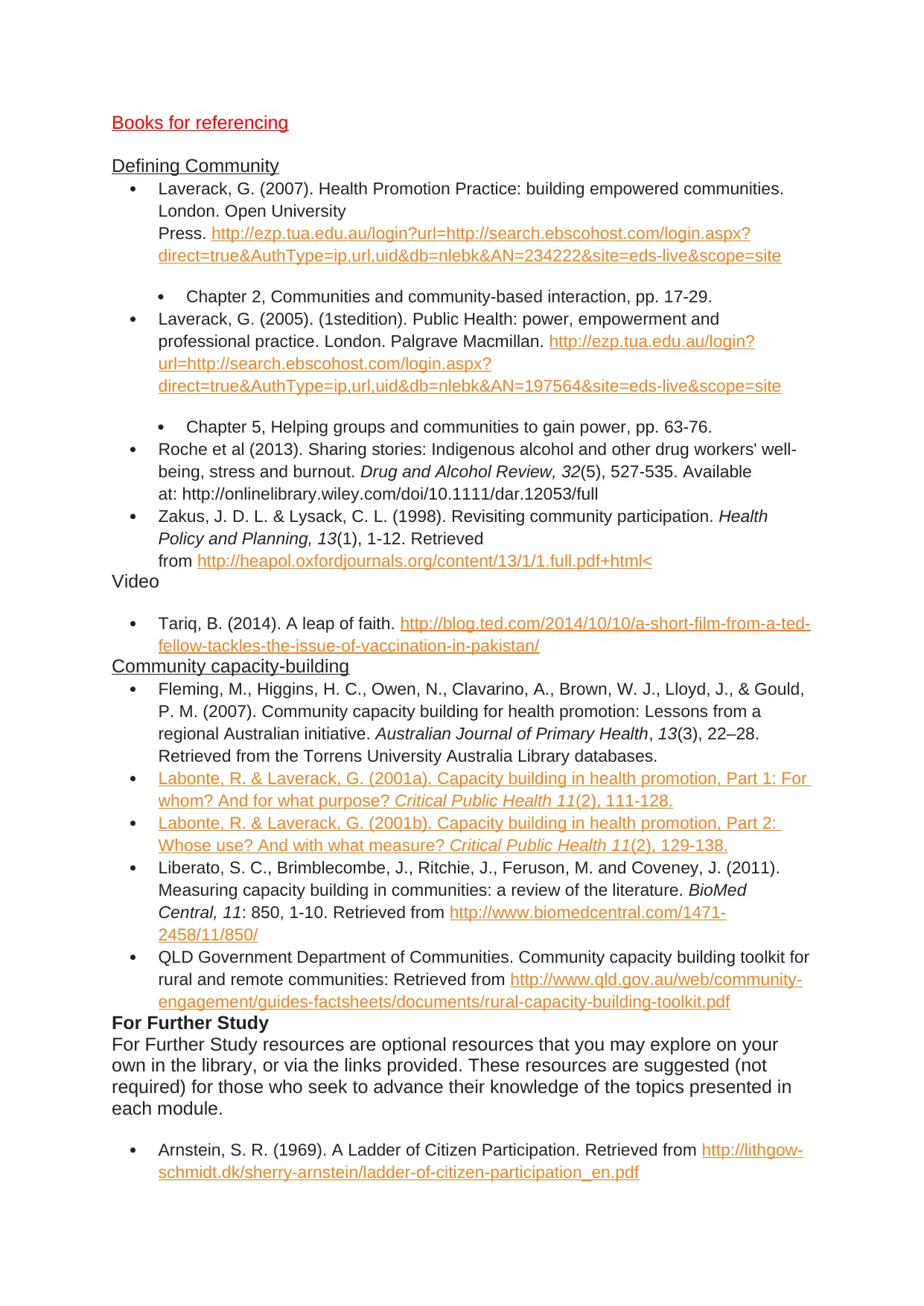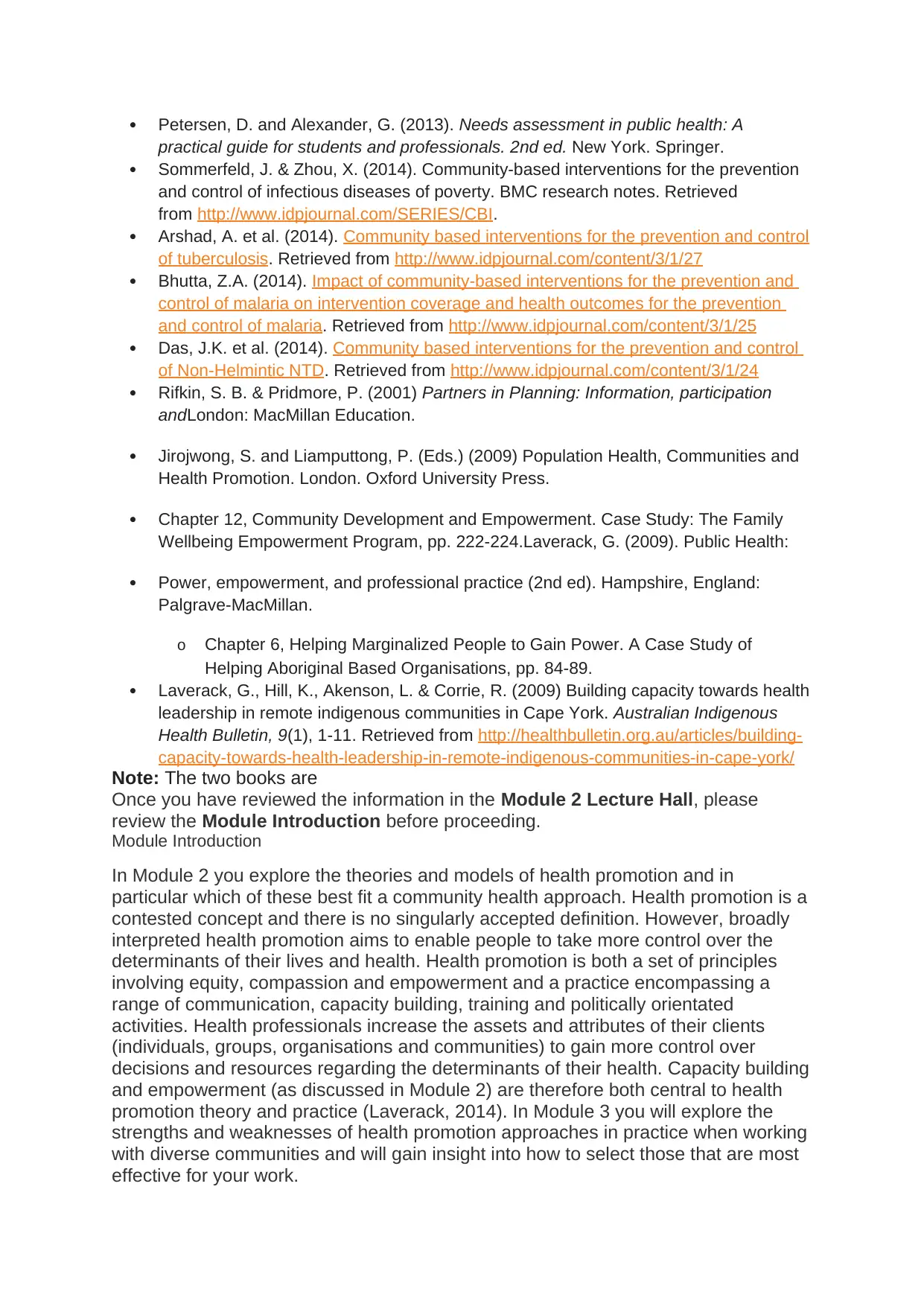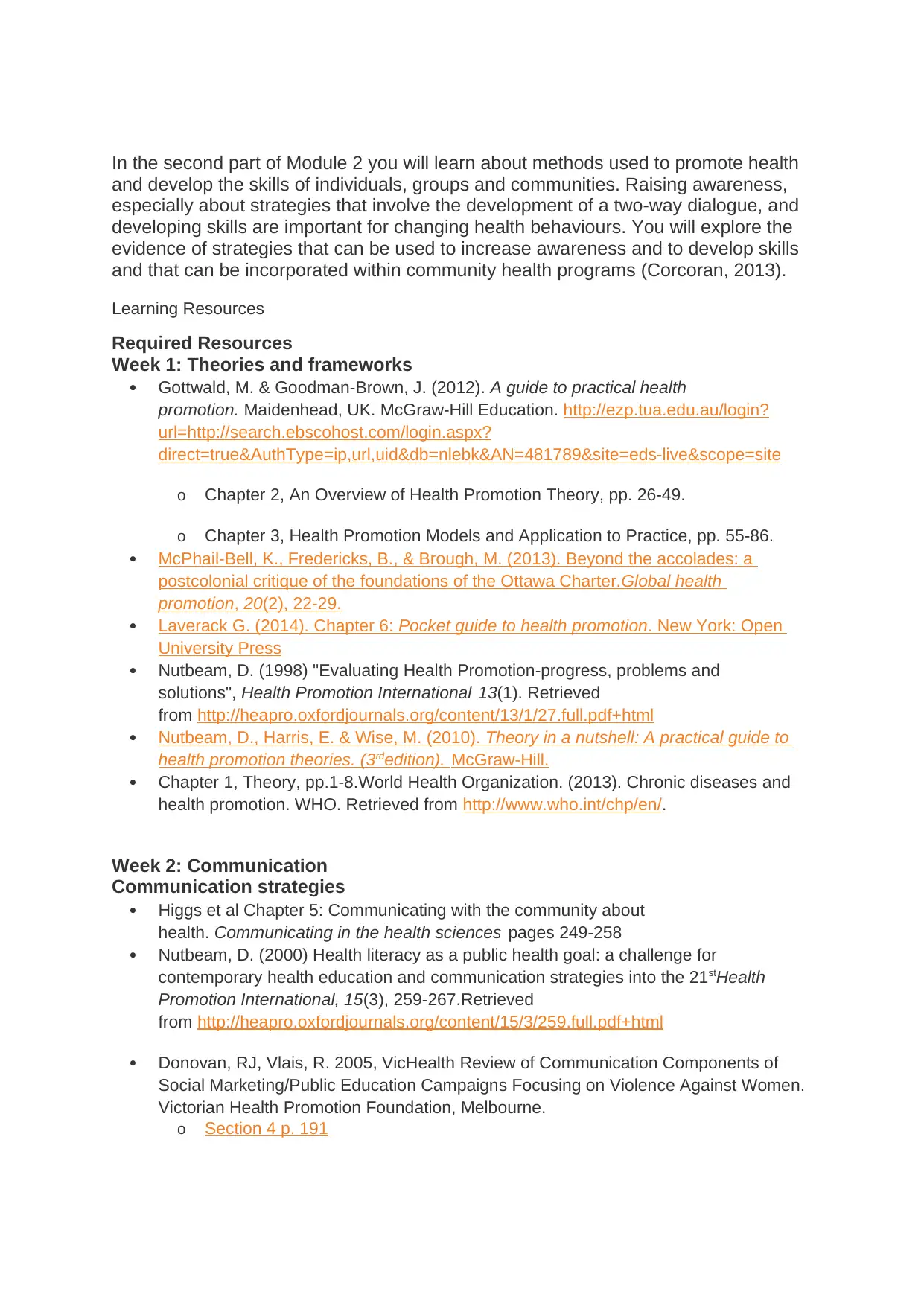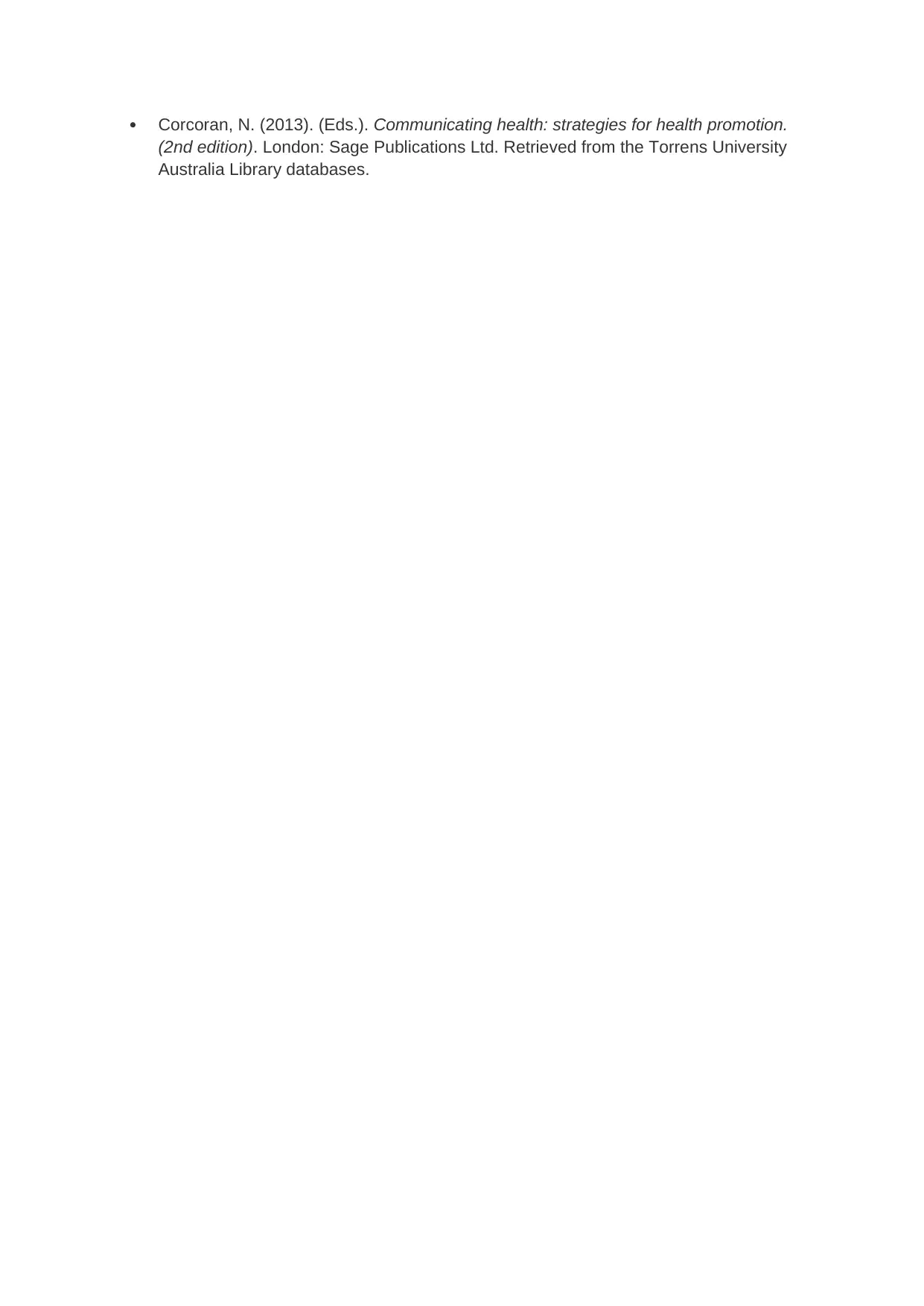Assessment in Public Health: A Practical Guide
VerifiedAdded on 2019/10/09
|4
|1526
|1061
Essay
AI Summary
This assignment provides a comprehensive overview of health promotion theories and frameworks, communication strategies, and community-based interventions for preventing and controlling infectious diseases of poverty. It also explores methods used to promote health, develop skills of individuals, groups, and communities, and discusses the importance of empowerment and capacity building in health promotion. The content draws from various sources, including books, articles, and online resources.
Contribute Materials
Your contribution can guide someone’s learning journey. Share your
documents today.

Books for referencing
Defining Community
Laverack, G. (2007). Health Promotion Practice: building empowered communities.
London. Open University
Press. http://ezp.tua.edu.au/login?url=http://search.ebscohost.com/login.aspx?
direct=true&AuthType=ip,url,uid&db=nlebk&AN=234222&site=eds-live&scope=site
Chapter 2, Communities and community-based interaction, pp. 17-29.
Laverack, G. (2005). (1stedition). Public Health: power, empowerment and
professional practice. London. Palgrave Macmillan. http://ezp.tua.edu.au/login?
url=http://search.ebscohost.com/login.aspx?
direct=true&AuthType=ip,url,uid&db=nlebk&AN=197564&site=eds-live&scope=site
Chapter 5, Helping groups and communities to gain power, pp. 63-76.
Roche et al (2013). Sharing stories: Indigenous alcohol and other drug workers' well-
being, stress and burnout. Drug and Alcohol Review, 32(5), 527-535. Available
at: http://onlinelibrary.wiley.com/doi/10.1111/dar.12053/full
Zakus, J. D. L. & Lysack, C. L. (1998). Revisiting community participation. Health
Policy and Planning, 13(1), 1-12. Retrieved
from http://heapol.oxfordjournals.org/content/13/1/1.full.pdf+html<
Video
Tariq, B. (2014). A leap of faith. http://blog.ted.com/2014/10/10/a-short-film-from-a-ted-
fellow-tackles-the-issue-of-vaccination-in-pakistan/
Community capacity-building
Fleming, M., Higgins, H. C., Owen, N., Clavarino, A., Brown, W. J., Lloyd, J., & Gould,
P. M. (2007). Community capacity building for health promotion: Lessons from a
regional Australian initiative. Australian Journal of Primary Health, 13(3), 22–28.
Retrieved from the Torrens University Australia Library databases.
Labonte, R. & Laverack, G. (2001a). Capacity building in health promotion, Part 1: For
whom? And for what purpose? Critical Public Health 11(2), 111-128.
Labonte, R. & Laverack, G. (2001b). Capacity building in health promotion, Part 2:
Whose use? And with what measure? Critical Public Health 11(2), 129-138.
Liberato, S. C., Brimblecombe, J., Ritchie, J., Feruson, M. and Coveney, J. (2011).
Measuring capacity building in communities: a review of the literature. BioMed
Central, 11: 850, 1-10. Retrieved from http://www.biomedcentral.com/1471-
2458/11/850/
QLD Government Department of Communities. Community capacity building toolkit for
rural and remote communities: Retrieved from http://www.qld.gov.au/web/community-
engagement/guides-factsheets/documents/rural-capacity-building-toolkit.pdf
For Further Study
For Further Study resources are optional resources that you may explore on your
own in the library, or via the links provided. These resources are suggested (not
required) for those who seek to advance their knowledge of the topics presented in
each module.
Arnstein, S. R. (1969). A Ladder of Citizen Participation. Retrieved from http://lithgow-
schmidt.dk/sherry-arnstein/ladder-of-citizen-participation_en.pdf
Defining Community
Laverack, G. (2007). Health Promotion Practice: building empowered communities.
London. Open University
Press. http://ezp.tua.edu.au/login?url=http://search.ebscohost.com/login.aspx?
direct=true&AuthType=ip,url,uid&db=nlebk&AN=234222&site=eds-live&scope=site
Chapter 2, Communities and community-based interaction, pp. 17-29.
Laverack, G. (2005). (1stedition). Public Health: power, empowerment and
professional practice. London. Palgrave Macmillan. http://ezp.tua.edu.au/login?
url=http://search.ebscohost.com/login.aspx?
direct=true&AuthType=ip,url,uid&db=nlebk&AN=197564&site=eds-live&scope=site
Chapter 5, Helping groups and communities to gain power, pp. 63-76.
Roche et al (2013). Sharing stories: Indigenous alcohol and other drug workers' well-
being, stress and burnout. Drug and Alcohol Review, 32(5), 527-535. Available
at: http://onlinelibrary.wiley.com/doi/10.1111/dar.12053/full
Zakus, J. D. L. & Lysack, C. L. (1998). Revisiting community participation. Health
Policy and Planning, 13(1), 1-12. Retrieved
from http://heapol.oxfordjournals.org/content/13/1/1.full.pdf+html<
Video
Tariq, B. (2014). A leap of faith. http://blog.ted.com/2014/10/10/a-short-film-from-a-ted-
fellow-tackles-the-issue-of-vaccination-in-pakistan/
Community capacity-building
Fleming, M., Higgins, H. C., Owen, N., Clavarino, A., Brown, W. J., Lloyd, J., & Gould,
P. M. (2007). Community capacity building for health promotion: Lessons from a
regional Australian initiative. Australian Journal of Primary Health, 13(3), 22–28.
Retrieved from the Torrens University Australia Library databases.
Labonte, R. & Laverack, G. (2001a). Capacity building in health promotion, Part 1: For
whom? And for what purpose? Critical Public Health 11(2), 111-128.
Labonte, R. & Laverack, G. (2001b). Capacity building in health promotion, Part 2:
Whose use? And with what measure? Critical Public Health 11(2), 129-138.
Liberato, S. C., Brimblecombe, J., Ritchie, J., Feruson, M. and Coveney, J. (2011).
Measuring capacity building in communities: a review of the literature. BioMed
Central, 11: 850, 1-10. Retrieved from http://www.biomedcentral.com/1471-
2458/11/850/
QLD Government Department of Communities. Community capacity building toolkit for
rural and remote communities: Retrieved from http://www.qld.gov.au/web/community-
engagement/guides-factsheets/documents/rural-capacity-building-toolkit.pdf
For Further Study
For Further Study resources are optional resources that you may explore on your
own in the library, or via the links provided. These resources are suggested (not
required) for those who seek to advance their knowledge of the topics presented in
each module.
Arnstein, S. R. (1969). A Ladder of Citizen Participation. Retrieved from http://lithgow-
schmidt.dk/sherry-arnstein/ladder-of-citizen-participation_en.pdf
Secure Best Marks with AI Grader
Need help grading? Try our AI Grader for instant feedback on your assignments.

Petersen, D. and Alexander, G. (2013). Needs assessment in public health: A
practical guide for students and professionals. 2nd ed. New York. Springer.
Sommerfeld, J. & Zhou, X. (2014). Community-based interventions for the prevention
and control of infectious diseases of poverty. BMC research notes. Retrieved
from http://www.idpjournal.com/SERIES/CBI.
Arshad, A. et al. (2014). Community based interventions for the prevention and control
of tuberculosis. Retrieved from http://www.idpjournal.com/content/3/1/27
Bhutta, Z.A. (2014). Impact of community-based interventions for the prevention and
control of malaria on intervention coverage and health outcomes for the prevention
and control of malaria. Retrieved from http://www.idpjournal.com/content/3/1/25
Das, J.K. et al. (2014). Community based interventions for the prevention and control
of Non-Helmintic NTD. Retrieved from http://www.idpjournal.com/content/3/1/24
Rifkin, S. B. & Pridmore, P. (2001) Partners in Planning: Information, participation
andLondon: MacMillan Education.
Jirojwong, S. and Liamputtong, P. (Eds.) (2009) Population Health, Communities and
Health Promotion. London. Oxford University Press.
Chapter 12, Community Development and Empowerment. Case Study: The Family
Wellbeing Empowerment Program, pp. 222-224.Laverack, G. (2009). Public Health:
Power, empowerment, and professional practice (2nd ed). Hampshire, England:
Palgrave-MacMillan.
o Chapter 6, Helping Marginalized People to Gain Power. A Case Study of
Helping Aboriginal Based Organisations, pp. 84-89.
Laverack, G., Hill, K., Akenson, L. & Corrie, R. (2009) Building capacity towards health
leadership in remote indigenous communities in Cape York. Australian Indigenous
Health Bulletin, 9(1), 1-11. Retrieved from http://healthbulletin.org.au/articles/building-
capacity-towards-health-leadership-in-remote-indigenous-communities-in-cape-york/
Note: The two books are
Once you have reviewed the information in the Module 2 Lecture Hall, please
review the Module Introduction before proceeding.
Module Introduction
In Module 2 you explore the theories and models of health promotion and in
particular which of these best fit a community health approach. Health promotion is a
contested concept and there is no singularly accepted definition. However, broadly
interpreted health promotion aims to enable people to take more control over the
determinants of their lives and health. Health promotion is both a set of principles
involving equity, compassion and empowerment and a practice encompassing a
range of communication, capacity building, training and politically orientated
activities. Health professionals increase the assets and attributes of their clients
(individuals, groups, organisations and communities) to gain more control over
decisions and resources regarding the determinants of their health. Capacity building
and empowerment (as discussed in Module 2) are therefore both central to health
promotion theory and practice (Laverack, 2014). In Module 3 you will explore the
strengths and weaknesses of health promotion approaches in practice when working
with diverse communities and will gain insight into how to select those that are most
effective for your work.
practical guide for students and professionals. 2nd ed. New York. Springer.
Sommerfeld, J. & Zhou, X. (2014). Community-based interventions for the prevention
and control of infectious diseases of poverty. BMC research notes. Retrieved
from http://www.idpjournal.com/SERIES/CBI.
Arshad, A. et al. (2014). Community based interventions for the prevention and control
of tuberculosis. Retrieved from http://www.idpjournal.com/content/3/1/27
Bhutta, Z.A. (2014). Impact of community-based interventions for the prevention and
control of malaria on intervention coverage and health outcomes for the prevention
and control of malaria. Retrieved from http://www.idpjournal.com/content/3/1/25
Das, J.K. et al. (2014). Community based interventions for the prevention and control
of Non-Helmintic NTD. Retrieved from http://www.idpjournal.com/content/3/1/24
Rifkin, S. B. & Pridmore, P. (2001) Partners in Planning: Information, participation
andLondon: MacMillan Education.
Jirojwong, S. and Liamputtong, P. (Eds.) (2009) Population Health, Communities and
Health Promotion. London. Oxford University Press.
Chapter 12, Community Development and Empowerment. Case Study: The Family
Wellbeing Empowerment Program, pp. 222-224.Laverack, G. (2009). Public Health:
Power, empowerment, and professional practice (2nd ed). Hampshire, England:
Palgrave-MacMillan.
o Chapter 6, Helping Marginalized People to Gain Power. A Case Study of
Helping Aboriginal Based Organisations, pp. 84-89.
Laverack, G., Hill, K., Akenson, L. & Corrie, R. (2009) Building capacity towards health
leadership in remote indigenous communities in Cape York. Australian Indigenous
Health Bulletin, 9(1), 1-11. Retrieved from http://healthbulletin.org.au/articles/building-
capacity-towards-health-leadership-in-remote-indigenous-communities-in-cape-york/
Note: The two books are
Once you have reviewed the information in the Module 2 Lecture Hall, please
review the Module Introduction before proceeding.
Module Introduction
In Module 2 you explore the theories and models of health promotion and in
particular which of these best fit a community health approach. Health promotion is a
contested concept and there is no singularly accepted definition. However, broadly
interpreted health promotion aims to enable people to take more control over the
determinants of their lives and health. Health promotion is both a set of principles
involving equity, compassion and empowerment and a practice encompassing a
range of communication, capacity building, training and politically orientated
activities. Health professionals increase the assets and attributes of their clients
(individuals, groups, organisations and communities) to gain more control over
decisions and resources regarding the determinants of their health. Capacity building
and empowerment (as discussed in Module 2) are therefore both central to health
promotion theory and practice (Laverack, 2014). In Module 3 you will explore the
strengths and weaknesses of health promotion approaches in practice when working
with diverse communities and will gain insight into how to select those that are most
effective for your work.

In the second part of Module 2 you will learn about methods used to promote health
and develop the skills of individuals, groups and communities. Raising awareness,
especially about strategies that involve the development of a two-way dialogue, and
developing skills are important for changing health behaviours. You will explore the
evidence of strategies that can be used to increase awareness and to develop skills
and that can be incorporated within community health programs (Corcoran, 2013).
Learning Resources
Required Resources
Week 1: Theories and frameworks
Gottwald, M. & Goodman-Brown, J. (2012). A guide to practical health
promotion. Maidenhead, UK. McGraw-Hill Education. http://ezp.tua.edu.au/login?
url=http://search.ebscohost.com/login.aspx?
direct=true&AuthType=ip,url,uid&db=nlebk&AN=481789&site=eds-live&scope=site
o Chapter 2, An Overview of Health Promotion Theory, pp. 26-49.
o Chapter 3, Health Promotion Models and Application to Practice, pp. 55-86.
McPhail-Bell, K., Fredericks, B., & Brough, M. (2013). Beyond the accolades: a
postcolonial critique of the foundations of the Ottawa Charter.Global health
promotion, 20(2), 22-29.
Laverack G. (2014). Chapter 6: Pocket guide to health promotion. New York: Open
University Press
Nutbeam, D. (1998) "Evaluating Health Promotion-progress, problems and
solutions", Health Promotion International 13(1). Retrieved
from http://heapro.oxfordjournals.org/content/13/1/27.full.pdf+html
Nutbeam, D., Harris, E. & Wise, M. (2010). Theory in a nutshell: A practical guide to
health promotion theories. (3rdedition). McGraw-Hill.
Chapter 1, Theory, pp.1-8.World Health Organization. (2013). Chronic diseases and
health promotion. WHO. Retrieved from http://www.who.int/chp/en/.
Week 2: Communication
Communication strategies
Higgs et al Chapter 5: Communicating with the community about
health. Communicating in the health sciences pages 249-258
Nutbeam, D. (2000) Health literacy as a public health goal: a challenge for
contemporary health education and communication strategies into the 21stHealth
Promotion International, 15(3), 259-267.Retrieved
from http://heapro.oxfordjournals.org/content/15/3/259.full.pdf+html
Donovan, RJ, Vlais, R. 2005, VicHealth Review of Communication Components of
Social Marketing/Public Education Campaigns Focusing on Violence Against Women.
Victorian Health Promotion Foundation, Melbourne.
o Section 4 p. 191
and develop the skills of individuals, groups and communities. Raising awareness,
especially about strategies that involve the development of a two-way dialogue, and
developing skills are important for changing health behaviours. You will explore the
evidence of strategies that can be used to increase awareness and to develop skills
and that can be incorporated within community health programs (Corcoran, 2013).
Learning Resources
Required Resources
Week 1: Theories and frameworks
Gottwald, M. & Goodman-Brown, J. (2012). A guide to practical health
promotion. Maidenhead, UK. McGraw-Hill Education. http://ezp.tua.edu.au/login?
url=http://search.ebscohost.com/login.aspx?
direct=true&AuthType=ip,url,uid&db=nlebk&AN=481789&site=eds-live&scope=site
o Chapter 2, An Overview of Health Promotion Theory, pp. 26-49.
o Chapter 3, Health Promotion Models and Application to Practice, pp. 55-86.
McPhail-Bell, K., Fredericks, B., & Brough, M. (2013). Beyond the accolades: a
postcolonial critique of the foundations of the Ottawa Charter.Global health
promotion, 20(2), 22-29.
Laverack G. (2014). Chapter 6: Pocket guide to health promotion. New York: Open
University Press
Nutbeam, D. (1998) "Evaluating Health Promotion-progress, problems and
solutions", Health Promotion International 13(1). Retrieved
from http://heapro.oxfordjournals.org/content/13/1/27.full.pdf+html
Nutbeam, D., Harris, E. & Wise, M. (2010). Theory in a nutshell: A practical guide to
health promotion theories. (3rdedition). McGraw-Hill.
Chapter 1, Theory, pp.1-8.World Health Organization. (2013). Chronic diseases and
health promotion. WHO. Retrieved from http://www.who.int/chp/en/.
Week 2: Communication
Communication strategies
Higgs et al Chapter 5: Communicating with the community about
health. Communicating in the health sciences pages 249-258
Nutbeam, D. (2000) Health literacy as a public health goal: a challenge for
contemporary health education and communication strategies into the 21stHealth
Promotion International, 15(3), 259-267.Retrieved
from http://heapro.oxfordjournals.org/content/15/3/259.full.pdf+html
Donovan, RJ, Vlais, R. 2005, VicHealth Review of Communication Components of
Social Marketing/Public Education Campaigns Focusing on Violence Against Women.
Victorian Health Promotion Foundation, Melbourne.
o Section 4 p. 191

Corcoran, N. (2013). (Eds.). Communicating health: strategies for health promotion.
(2nd edition). London: Sage Publications Ltd. Retrieved from the Torrens University
Australia Library databases.
(2nd edition). London: Sage Publications Ltd. Retrieved from the Torrens University
Australia Library databases.
1 out of 4
Related Documents
Your All-in-One AI-Powered Toolkit for Academic Success.
+13062052269
info@desklib.com
Available 24*7 on WhatsApp / Email
![[object Object]](/_next/static/media/star-bottom.7253800d.svg)
Unlock your academic potential
© 2024 | Zucol Services PVT LTD | All rights reserved.





